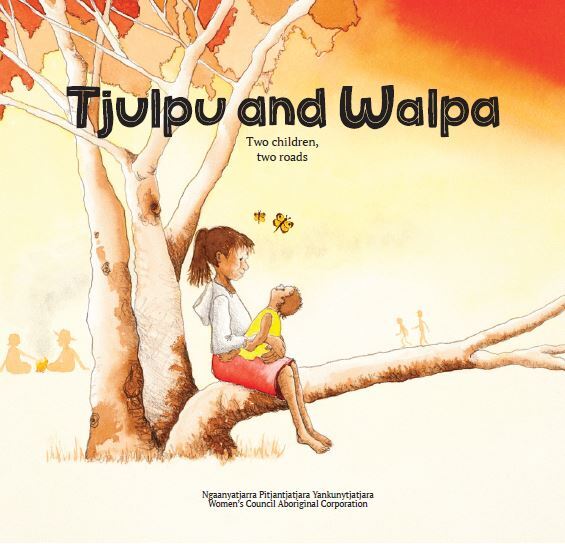This picture book is inspired by the childhood memories of the various authors, and has been written to educate and empower both adults and youth in the community.
‘Tjulpu and Walpa’ tells the contrasting stories of two girls. Tjulpu (‘bird that sings’) is raised in a supportive and loving environment, where she is nurtured and protected from birth and learns about culture and family. She grows to understand the ways in which she can be a good parent to her own future children. We then hear Walpa’s story – which is a stark contrast to that of Tjulpu’s. Walpa (‘the wind’) is raised in an unstable environment, and she spends her days afraid and hiding, or running away and fighting. Without the supportive and caring environment that Tjulupu had, Walpa ends up pregnant and alone as a young teen, afraid for her future and the future of her unborn child.
While both these stories are quite different – one imbued with warmth and the other highlighting the harsh realities of domestic violence and neglect, they both ultimately end on a hopeful note, with Walpa’s extended family finally stepping in to offer support.
This book is designed for use by community workers, parents, families and communities, to shine a light on the way in which different family backgrounds can shape the trajectory of a young person’s life. We see – in both stories – the way in which family support and care can help a child grow strong and safe, and shape the environment in which they later raise their own children.
Walpa’s story is not an easy one to read – but it is an important one to learn from and to deepen an understanding of the ways in which the cycle of intergenerational trauma can be broken.
Both stories are narrated in a direct and conversational voice, accessible for both adults and older children. The voices of Tjulpu and Walpa incite feelings of both warmth and heartbreak.
The accompanying expressive illustrations show darkness and shadows, but also heart and hope. The narrators – Tjulpu and Walpa – are rendered on the page in soft bright colours, contrasting with the black and white settings behind them, an effective way of centering their voices and stories. The final illustration of Walpa bonding with her small child is particularly touching and beautifully ties these two separate stories together with an ultimate message of hope.
Visual prompts are provided at the conclusion of this book for further discussion around themes raised in the book.
Uti Kulintjaku is a group of senior Indigenous women and traditional healers from Central Australia who are concerned about the wellbeing of their family and community members.

